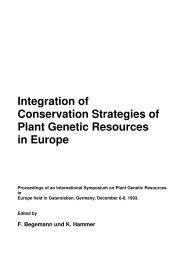Zugang zu Pflanzengenetischen Ressourcen für die ... - Genres
Zugang zu Pflanzengenetischen Ressourcen für die ... - Genres
Zugang zu Pflanzengenetischen Ressourcen für die ... - Genres
Sie wollen auch ein ePaper? Erhöhen Sie die Reichweite Ihrer Titel.
YUMPU macht aus Druck-PDFs automatisch weboptimierte ePaper, die Google liebt.
ureaucracy would be created to handle these aspects.<br />
W. E. SIEBECK<br />
Another problem with such proposals is that in most cases it is not clear what shall be protected.<br />
For an intellectual property right the subject-matter to be protected and the scope of such<br />
protection have to be known (and in the case of a patent to be disclosed). Information to be<br />
protected as farmers' rights would be unspecific, and often be expected to cover unknown traits.<br />
While again it would not be inconceivable to design such a right, the defense of such right would<br />
seem extremely difficult. Unfortunately, the protracted debates in FAO about farmers' rights as an<br />
intellectual property right distracted attention from the need to translate a valid equity based<br />
concept into an operative formula. There seem basically three options available for doing this:<br />
The first option would be a commercial one. It would take its cue from the mentioned Costa Rica<br />
arrangement with Merck & Co and would require countries that want to supply their germplasm<br />
to put a marketing infrastructure in place. They would collect, screen, characterize and catalogue<br />
their material and store it in a genebank. Few developing countries have so far attempted to do<br />
so in a systematic fashion.<br />
A second option would be to allow the continued exchange of germplasm, including collection in<br />
countries of origin (and later releases of such material to users from genebanks) if it is understood<br />
that any revenues will have to be shared with the country of origin. This is basically the philosophy<br />
underlying the Biodiversity Convention. The concern is that with all the safeguards and conditions<br />
the Convention prescribes for transfer arrangements, the country of origin will be left to its own<br />
devices to fend for its claims, and may often not have the wherewithal (for lack of information and<br />
funds) to do so.<br />
The third option is the one discussed in FAO: a fund to be fed from contributions from the<br />
industrial countries, either from an ear-marked tax (e.g. on seed sales), or additional aid payments.<br />
The current mood in developed countries would not seem to support either proposal. One should<br />
also doubt whether a mechanism (such as a steering committee) to oversee the allocation of the<br />
proceeds from such a fund would be able to channel them to those who have done most for the<br />
conservation of biodiversity. More likely, such decisions will be made on political grounds, and<br />
funds would reward the wrong recipients.<br />
The preferred solution should try to combine options one and two: it would encourage countries<br />
to market their germplasm on their own terms, while facilitating benefit-sharing for all others.<br />
7 Final Remarks<br />
The Convention provides a framework for international collaboration in the conservation of<br />
biological diversity. Protocols remain to be negotiated between countries on access to genetic<br />
resources and technology transfer. Its success will depend on the spirit and attitude with which<br />
countries pursue its implementation. If this takes place in an adversarial spirit, the consequences,










